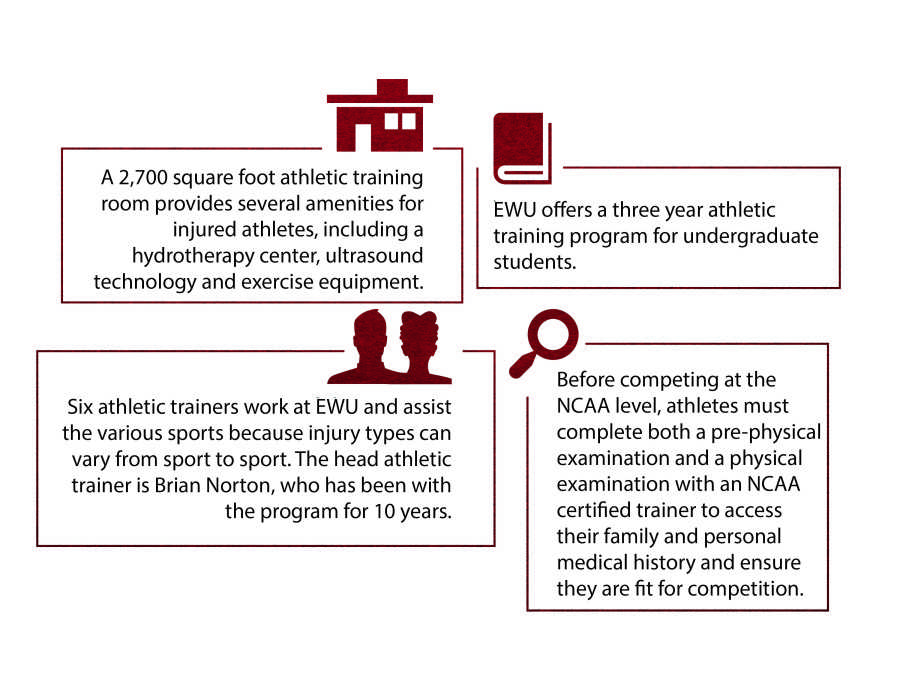Athletes receive treatment and training
February 5, 2014
Trainers keep students in tip-top shape for competition
Injuries will always be a constant adversity that all athletes will have to deal with no matter what sport they perform in.
Athletes rely on athletic trainers and doctors to diagnose and treat their injuries. Eastern’s current athletic department is composed of six certified athletic trainers, who cover all of Eastern’s division 1 NCAA sports.
“There [are] a lot of sports that are in season, and a lot of sports that are out of season,” Assistant Athletic Director Brian Norton said. “I cover football; we have several guys that either had to have surgery at the end of the season, or are dealing with an injury that we’re rehabbing right now to try and get them better.”
Norton’s list of injured football players ranges from 10-14 athletes who need assistance from him. Norton states that not all of the players on this list have major injuries, but some of them are post-surgical, and need extensive rehab time.
Several of these athletes are quarterbacks, receivers and lineman. Norton also currently works with Eastern’s football players that are getting ready to work out with professional teams. “We don’t want anybody to leave here broken, that’s why we want to make sure everybody is taken care of,” Norton said.
The typical day for the athletic department starts at 7 a.m. and ends at 6 p.m. The reason for the early start is to accommodate the class schedules of athletes. “We don’t want to have a kid miss class to do rehab,” Norton said.
Visits from athletes usually decrease from 8-11 a.m., which is typically when most classes occur. According to Norton, the number of visits starts to expand at around noon. Some of Eastern’s athletes usually have afternoon class as well, so they try to meet with athletic trainers from noon-1 p.m.
The operation hours are five days a week. “We try to get stuff done in the off-season in those five days prior to the weekend,” Norton said. The athletic trainers try to give the athletes a day off to take a break from the obligations of rehabbing.
Assistant Athletic Trainer Kacey Hoob is in charge of injured women’s basketball players as well as tennis. Hoob currently is working a few injured basketball players, one of which is rehabbing after an ACL reconstruction surgery. Hoob is also working an athlete that is currently playing through a knee injury, plus some common ankle injuries that she has treated throughout the year.
For tennis, injuries differentiate from the contact heavy basketball. “They have a lot of more of the chronic type injuries, it’s a non-contact sport so they’re not getting knocked over,” Hoob said. She also mentions that she deals with treating back injuries for tennis athletes as well shoulder injuries.
“There’s a lot of maintenance that I want my athletes to do. If they [have] something that’s just a bit of a nagging injury, I require that they come in 40-30 minutes before their practice time,” Hoob said. “When it comes to something that’s a little bit more severe, something that’s acute, something that they’re trying to kind of work through, I require them to come in about an hour or so early before their practice.”
Hoob also states that the athletic department requires severe injured athletes to come in after practice to go through methods of icing treatment or various other rehabs. “When an athlete gets injured, they have a lot of responsibility,” Hoob said. “They are required about another hour and a half time on top of their practice time, their weight time, their studying [and] their school work. They have to put in a lot of time to get back on the court for sure.”
The EWU athletic department also tries to get athletes to keep up with their fitness regimen when they take time off from their sports due to injury. “We [try] to have a goal for them to attain, it’s really difficult to take a week off and come back and still be as good a shape as you were,” Assistant Athletic Trainer Shawn Edgerly said.
Edgerly mentions that the athletic training department usually has the athletes try to stay in shape while taking time off from their sport because of injuries. This happens by getting on a stationary bike, or doing certain workouts to keep the athletes in shape.
Trainers deal with many aspects when working with an injured athlete. “You definitely have to have a passion for the career,” Edgerly said. “A lot of us are not necessarily doing it just for the paycheck, but just [because] we love to be here and work with athletes.”









